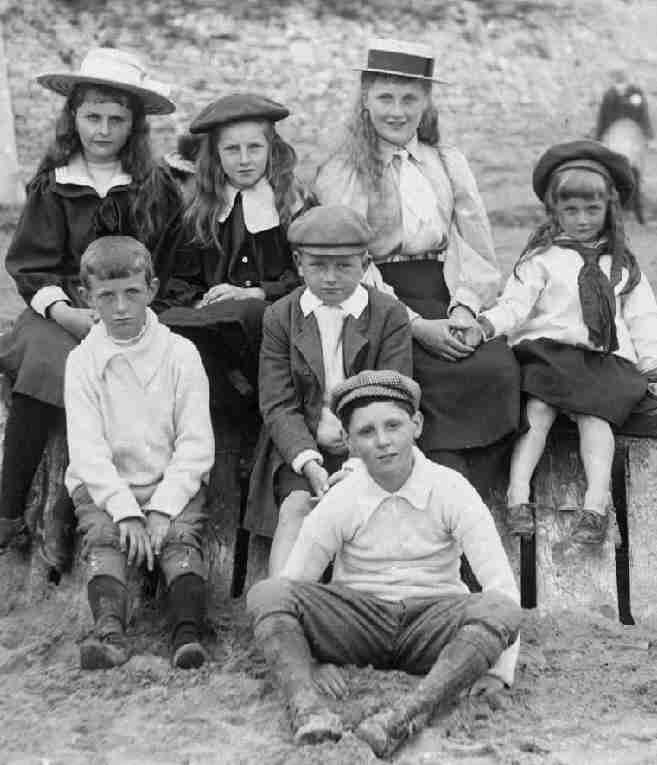
Seaside Resorts and Clothing: Chronology

Figure 1.-- This English cabinet card shows what children were wearing on the beach at around the turn of the century. There were no identifying marks as to location,
photographer, subject, date etc. I would estimate it to be around 1900. Image courtesy of the MD collection.
|
Seaside resorts by the late 19th century were well-established resorts. Sea bathing for the wealthy became popular in the 18th century. The seaside did not become
a possibility for the average person until the late 19th century. This was a side affect of the industrial revolution. The new railroads provided the means of rapidly
transporting large numbers of people, rapidly, and at low cost. Another product of the developing industrial work place--the paid vacation. Many workers would
flock to the seaside for their vacations. This occurred first in England where the industrial revolution was the modt advanced and beaches were closest to the
industrial cities. The vacationers loved to have their portraits taken which provide a wonderful chronological record of fashions. Wealthy children might have outfits especially for the beach. Other children mught wear their ordinary clothing. This of course changed as Europeans becam increasingly prosperous. The sea in northern Eurpe could be quite cold, thus children were often dressed to play on the beach and not swim.
Ancient Civilizations
We have little information about the erliest civilizations and attitudes about the beach. We do know that the Greeks looked on the seaside as both a place of health and physical development. There are indications of Greek bathing dating back to 500 BC. The Romans established many beach resports, The first was Bahia about 50 BC. Many others developed such as Herculinium near Pompey.
Medieval Era
With the fall of Rome in the 5th century AD and the rise of the Christian Church, attitudes toward the beachchanged. First of all there was a decline in material wealth and fewer people had the ability to seek diversion. More important the health interests and te desore to develop one's body that had been prsued by the Greeks and Romans disappeared. Christian theologians were more likely to look on the body as the root of all evil. Th Bible refrs to the sea as the "the Great abyss". Medievel man saw the sea as sinester and populted with all manner of monsters. So for over a millenia, the beach as place of recreation was a concept alien to the Christian West. Few ventured into the sea or even knew how to swim and this included mariners.
We have little information about the 17th century. We note that in the 17th century that there were the voyages of discovery. This brought the Europeans in contact with peoples in tropicl areaswho had a very different attitude toward beaches. Sea bathing for the wealthy became popular in the 18th century. Few Europeans knew how to swim in the 18th century. The first European bathing academy was apparently opened in France during 1755. The Europeanns who learned to swim generally learned a breast stroke, it was not until the turn of the 20th century that modrn siming stylkes like the Australian crawl appeared. European interest in beaches was especially pronounced in England, but it was a very different concept. The English began to think of the beach as a healthy experience. It was not so much the sun which in England often did not cooperate, but the English began to see medicinal value in seawater. Standards of decency had involved by the turn of the 19th century. Women wore incredibly voluminous wool bathing dresses that once soaked with water were incredibly heavy abd restrictive. Beach resorts began to develop. Two of the earliest in England were Brighton and Scarborough. Bathers in the early 19thcentury were assisted, there were dipper to assist the ladies and bathers to assist the men. The bathing machines that appeared in the 18th century were still an iportant feature of the 19th centuy beach. British attitudes began to change after the Napoleonic Wars (1800-15) hen the British eliete began to visit the Continent again. Visitors to Italy noticed a more recreational attitude toward beach going in Italy and this began to take hold in England by the mid-19th century. In the early 19th century, beach going was still a recreation for the wealthy. This began to change after mid-century as the industrial revolution altered the face of Britain. Most people could still not swim at the turn of the 20th century. Life lines were installed at beaches. Beah resort appeared in many European contries. In America th most famous was Coney Island which offered not only the sea, but a vast array of amusements. Some beach resorts built indoor seawater pools so bathers could avoid the dangers of the waves and surf. Only after World War I did bathing suits began to develop along modern line.
HBC

Navigate the Boys' Historical Clothing Web Site:
[Return to the Main Seaside Activities page]
[Introduction]
[Biographies]
[Catalogs]
[Chronology]
[Clothing styles]
[Countries]
[Girls]
[Literary]
[Bibliographies]
[Contributions]
[FAQs]
[Glossaries]
[Satellite sites]
[Tools]
[Boys' Clothing Home]
Navigate the Boys' Historical Clothing Web Site:
[Sailor suits]
[Sailor hats]
[Buster Brown suits]
[Eton suits]
[Rompers]
[Tunics]
[Smocks]
[Pinafores]
Created: June 27, 2003
Last updated: July 21, 2003



